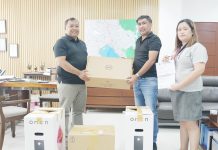
ROSARIO, Northern Samar – Residents of this coastal town are happy now that they have a source of potable water.
Although the water system already existed in the town, it is still just considered as Level II as the water distribution had not reach houses but through a tap stand, strategically installed in specific places of the villages.
The water system uses ground water as a source and being pump to the treatment facility funded under the program of the Department of Interior and Local Government (DILG).
Residents in the town proper are using the water for laundry, cooking, cleaning chores and for taking a bath.
“We are allowed to fetch at least six containers of water a day. That is already enough for our daily needs,” Matilde Pestaño, a resident of Barangay Poblacion, said.
Her family uses the water for taking bath and cooking. For drinking, they buy water at the refilling stations.
“Since it is not enough for our daily needs, the water we used in bathing is also used for the comfort room,” Pestaño shares.
She added that for washing clothes, this has to be done once a week to conserve water.
Her fellow resident, Rosa Opilanda, shares the same feeling with Pestaño.
“Unlike before that we need to walk to another village to fetch water, now it’s almost within our doorstep,” she said.
“But this will be better if the water system reaches each house because we no longer need to queue to fetch water,” Opilanda added.
The operation of the water system is from one to two hours a day and residents have to pay for P1 per water container. They are also encouraged to help in securing and protecting the water system project.
The water system project in Rosario worth P9 million is funded by the DILG under the program Assistance to Disadvantaged Municipalities (ADM).
The ADM program provides a “catch-up mechanism” to assist municipal governments in increasing citizens’ access to basic facilities and ensures participation of civil society organizations (CSOs) in local governance. Project types funded by ADM program are water system, evacuation facility, local access roads, small water impounding, and sanitation and health facilities.
The DILG is one of the 28 agencies involved in the water sector with the implementation of national programs such as the Sagana at Ligtas na Tubig Para sa Lahat (Salintubig), Bottom-up Budgeting (BuB)- Water Supply, Assistance to Municipalities (AM)- Water Supply, and Local Government Support Fund (LGSF)- Water.
“Prior to the implementation of the project, one of the requirements was to come up with a barangay assembly to mobilize community participation especially in the protection of the project,” Director Danny Laguitan, provincial local operations officer, said.
The implementation of the water system project by the Department of Interior and Local Government (DILG) requires local government units to gets a permit or approval from the Department of Environment and Natural Resources.
“We realized, especially if the LGU is located along coastal area, that there could be in the future water incursion. When much ground water is pump, salt water comes in that increases the salinity affecting water potability and also destroying plants,” DILG Regional Director Artemio Caneja said.
“That is the requirement. Without the permit from DENR, we will not implement the project. If they say that we cannot get the source of water in this area, the LGU must look for another place for their source of water,” he added.
Caneja added that implementing a water system project is not that easy because there are municipalities and villages that do not have sources of water.
The DILG regional chief pointed out his experience while he was still the provincial director of DILG in Leyte where it took them four years to finished the project because they to look for a source of water since the town beneficiary is really waterless.
He added that one of the requirements of the project is for the beneficiaries awarded with a Seal of Good Local Governance (SGLG).
The SGLG originated from the Seal of Good Housekeeping (SGH) which is DILG’s response to the clamor of the people for integrity and performance in public service. It challenges local governments to continue good governance practices while providing better public services.
SGLG awardees are given opportunity to have a share at the Performance Challenge Fund, multimillion-peso incentive for local development projects.
“But for those that are not SGLG passers, they can still benefit the project but the DILG does not download it to the LGU but to the provincial government to implement the project,” Caneja explained.
(ROEL T. AMAZONA)



